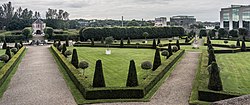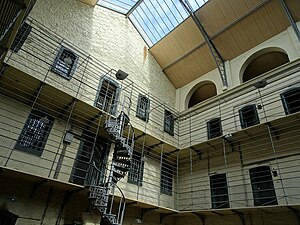Difference between revisions of "Kilmainham"
(Created page with "{{Infobox town |name=Kilmainham |irish=Cill Mhaighneann |county=Dublin |picture=Museum Of Modern Art At Royal Hospital Kilmainham - Dublin (Ireland) - panoramio (7).jpg |pictu...") |
(No difference)
|
Latest revision as of 22:29, 26 February 2021
| Kilmainham Irish: Cill Mhaighneann | |
| County Dublin | |
|---|---|
 The Museum of Modern Art, Kilmainham | |
| Location | |
| Grid reference: | O127337 |
| Location: | 53°20’31"N, 6°18’29"W |
| Data | |
| Postcode: | D8 |
| Local Government | |
Kilmainham is a village of County Dublin, hemmed in as a suburb by the City of Dublin and close beside the city centre. It is south of the River Liffey and west of the city centre. Its name is from the Irish Cill Mhaighneann, meaning 'St Maighneann's church'.
History
In the Viking era, the monastery was ousted to play host to the first Norse base in Ireland.[1]
In the 12th century, the lands on the banks of the Liffey first belonged to the Knights Templar, and Strongbow built them a castle about a mile distant from the Danish wall of old Dublin. Hugh Tyrrel, first Baron Castleknock, granted the Templars part of the lands which now form Phoenix Park. Here the Templars flourished, for nearly a century and a half, until the Order was suppressed by King Edward II in 1308: thirty members of the Order were imprisoned and examined in Dublin, the Order of the Knights Templar was condemned and suppressed and their lands and privileges were given to the priory of the Knights of St John of Jerusalem (the Knights Hospitaller), who remained in possession until the dissolution of the monasteries in the 16th century.[2]
Until the time of Queen Elizabeth, when Dublin Castle became the centre of power, the Lord Lieutenants often held court at the manor of Kilmainham. In 1559, Thomas Radclyffe, 3rd Earl of Sussex, on being again appointed Lord Lieutenant, found that the building at Kilmainham had been damaged by a storm, and had to hold court at the palace of St. Sepulchre. The following year Elizabeth ordered that Dublin Castle be upgraded to enable the Lord Lieutenant to reside there, and Kilmainham fell out of favour.[2]
The Manor of Kilmainham formed a liberty outside the jurisdiction of the city of Dublin, with its own rights and privileges. The manor took in parts of James's Street and side-streets and stretched as far as Lucan and Chapelizod.[3] After the Reformation, former lords (or chairmen, as they were later called) of this manor included Lord Cloncurry and Sir Edward Newenham. John "Bully" Egan, from Charleville, County Cork, was chairman from 1790 to 1800. These manorial rights were abolished after the Municipal Corporations (Ireland) Act 1840, and much of the area was included within the city's municipal bounds, leaving 'New Kilmainham' outside until 1900.
From 1868, New Kilmainham comprised the townlands of Kilmainham, Goldenbridge North, Inchicore North, Inchicore South, and Butchers Arms. Its total area was 580 acres and the population 5,391 in 1881; 6,519 in 1891. In 1900 the township was absorbed into the municipal boundary of Dublin city.
Local attractions
The area is best known for Royal Hospital Kilmainham, constructed on the site where the Knights Hospitaller had their priory in Dublin. It now houses the Irish Museum of Modern Art. Nearby is Kilmainham Gaol, where the executions of the leaders of the Easter Rising took place.
Kilmainham holds one of a small number of Viking era burial sites (Old Norse haugr meaning barrow or mound), within Dublin, others including Bully's Acre and where College Green is now located.
Outside links
| ("Wikimedia Commons" has material about Kilmainham) |
